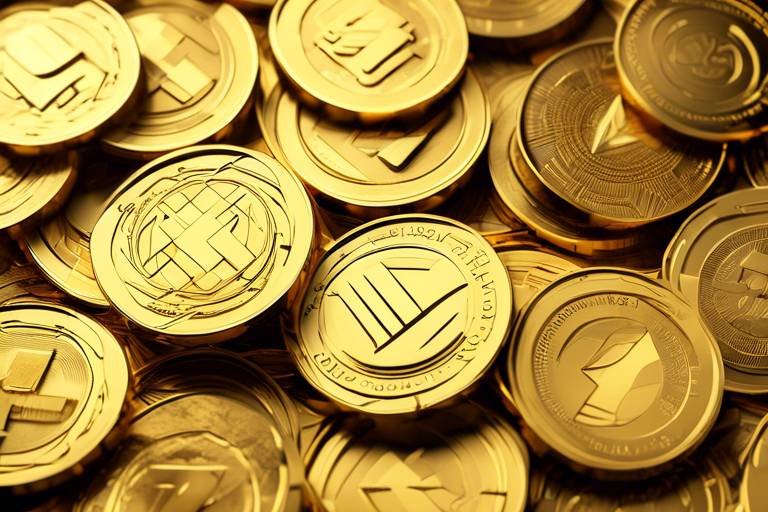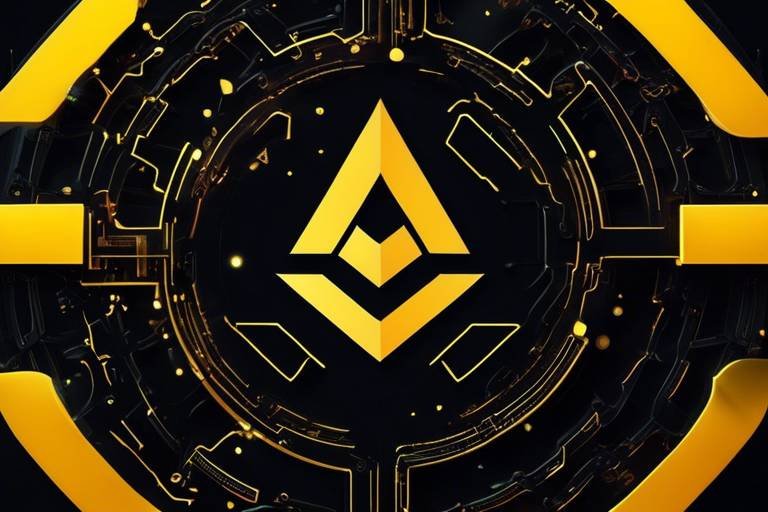Elrond (EGLD) - A High-Speed Blockchain Solution
In the ever-evolving world of blockchain technology, Elrond stands out as a beacon of innovation, designed to tackle the challenges of speed and scalability head-on. Imagine a highway where cars zoom past without traffic jams, delivering goods swiftly and efficiently; that’s the essence of Elrond’s blockchain experience. With its unique architecture and forward-thinking approach, Elrond is not just another blockchain platform; it’s a revolution in how we perceive and utilize blockchain technology.
Elrond's primary focus is on providing a seamless and efficient blockchain experience that caters to the needs of developers and users alike. What sets Elrond apart in a crowded market? It's all about its ability to process transactions at lightning speed while maintaining a high degree of security and decentralization. This platform is built on the principles of high throughput and low latency, making it an attractive option for developers looking to create applications that require rapid and reliable transaction processing.
The architecture of Elrond is designed to be both robust and flexible. It employs a unique combination of technologies that allow it to scale effectively, ensuring that as more users join the network, the performance does not degrade. Think of Elrond as a well-oiled machine, where each cog plays a critical role in maintaining the overall efficiency. With its innovative solutions, Elrond is paving the way for a new era of blockchain technology that prioritizes user experience and developer accessibility.
One of the most remarkable aspects of Elrond is its ability to support a wide array of applications. From decentralized finance (DeFi) to non-fungible tokens (NFTs), Elrond provides the infrastructure necessary for developers to create and deploy their projects with ease. This versatility opens up a world of possibilities, allowing innovators to explore new frontiers in the blockchain space. With Elrond, the potential for growth and development is virtually limitless.
As we dive deeper into the intricacies of Elrond, we will uncover the innovative consensus mechanisms that underpin its operations, the use cases that highlight its capabilities, and the promising future that lies ahead for this groundbreaking platform. Buckle up, as we embark on a journey through the world of Elrond, where speed meets security, and innovation knows no bounds.
- What is Elrond? - Elrond is a high-speed blockchain platform designed for scalability and efficiency, enabling fast transactions and a wide range of applications.
- How does Elrond achieve high transaction speeds? - Elrond utilizes a unique consensus mechanism called Adaptive State Sharding, which allows for parallel processing of transactions.
- What are the main use cases for Elrond? - Elrond supports various applications, including decentralized finance (DeFi) and non-fungible tokens (NFTs), among others.
- What makes Elrond different from other blockchains? - Elrond's combination of high throughput, low latency, and innovative consensus mechanisms sets it apart from traditional blockchain solutions.

Overview of Elrond
Elrond is not just another blockchain; it's a revolutionary platform engineered to redefine the way we think about speed and scalability in the digital world. Imagine a highway where cars can zoom past without traffic jams—this is the essence of Elrond. It was built from the ground up to tackle the limitations of traditional blockchains, which often struggle with slow transaction speeds and high fees. With Elrond, users experience a seamless and efficient blockchain experience, making it a game-changer in the industry.
At the heart of Elrond's architecture lies its commitment to high throughput and low latency. This means that transactions are processed almost instantaneously, allowing for a user experience that feels as smooth as a well-oiled machine. The platform's unique features include:
- Scalability: Elrond can handle thousands of transactions per second, making it suitable for mass adoption.
- Low Fees: The cost of transactions on Elrond is significantly lower than on many other platforms, encouraging widespread use.
- Interoperability: Elrond is designed to work seamlessly with other blockchains, enhancing its versatility.
What sets Elrond apart is its innovative approach to solving the issues that plague many existing blockchain systems. Rather than relying on outdated technologies, Elrond leverages a combination of cutting-edge techniques to create a robust ecosystem. This includes features such as smart contracts that are not only efficient but also easy to deploy and manage. Developers can create applications that are not only fast but also secure, paving the way for a new era of decentralized applications (dApps).
In summary, Elrond's architecture is a perfect blend of speed, security, and scalability. As we dive deeper into its consensus mechanism and various use cases, it becomes evident that Elrond is not just a fleeting trend; it is a platform poised to make a lasting impact on the blockchain landscape.

Consensus Mechanism
Elrond's approach to blockchain technology is nothing short of revolutionary, particularly when it comes to its . The platform employs a unique combination of Adaptive State Sharding and Secure Proof of Stake, setting it apart from traditional blockchain systems. But what exactly does this mean for users and developers? Let's dive into the intricacies of this innovative mechanism and how it enhances both transaction speed and network security.
At the heart of Elrond's consensus mechanism is the concept of Adaptive State Sharding. This method allows the network to divide its workload into smaller, more manageable pieces, or "shards." Each shard can process transactions independently and simultaneously, vastly improving the network's overall throughput. Think of it like a busy restaurant: instead of one chef trying to prepare all the dishes at once, the kitchen is divided into several stations, each handling different orders. This not only speeds up service but also enhances the overall dining experience.
Adaptive State Sharding is particularly significant because it allows Elrond to dynamically adjust the number of shards based on network demand. When transaction volume spikes, the network can create additional shards on-the-fly, ensuring that it remains responsive and efficient. This adaptability is crucial in a world where transaction volumes can fluctuate dramatically. It's like having a flexible workforce that can scale up or down depending on the rush hour.
The benefits of implementing sharding in Elrond are manifold:
- Increased Scalability: By processing multiple transactions in parallel, Elrond can handle a significantly higher volume of transactions compared to traditional blockchains.
- Reduced Congestion: With transactions spread across various shards, the likelihood of network congestion is minimized, leading to faster transaction confirmations.
- Enhanced User Experience: Users benefit from quicker transaction times, making the platform more appealing for applications requiring speed, such as DeFi and NFTs.
However, sharding is not without its challenges. Maintaining security and efficiency while implementing this innovative approach can be tricky. For instance, when shards operate independently, there’s a risk that some shards may become less secure than others. Additionally, ensuring that all shards can communicate effectively without bottlenecks is a complex task. Elrond's developers are continually working to address these challenges, ensuring that the network remains robust and secure.
Complementing the Adaptive State Sharding is Elrond's Secure Proof of Stake mechanism. Unlike traditional Proof of Work systems that require massive energy consumption to validate transactions, Secure Proof of Stake relies on validators who are chosen based on the amount of EGLD they hold and are willing to "stake" as collateral. This not only reduces energy consumption but also promotes decentralization, as anyone can participate in the validation process by staking their tokens.
In conclusion, Elrond's consensus mechanism is a game-changer in the blockchain arena. By combining Adaptive State Sharding with Secure Proof of Stake, it offers a scalable, efficient, and secure platform that is poised to meet the demands of the digital age. As the blockchain landscape continues to evolve, Elrond is paving the way for a new era of blockchain technology that prioritizes speed and security without compromising on decentralization.
Q1: What is the main advantage of Elrond's consensus mechanism?
A1: The main advantage is the combination of Adaptive State Sharding and Secure Proof of Stake, which allows for high-speed transactions and improved scalability while maintaining network security.
Q2: How does Adaptive State Sharding work?
A2: Adaptive State Sharding divides the network into smaller shards that can process transactions simultaneously, allowing the network to handle a larger volume of transactions efficiently.
Q3: What challenges does Elrond face with sharding?
A3: The challenges include maintaining security across different shards and ensuring effective communication between them to prevent bottlenecks.
Q4: How does Secure Proof of Stake differ from traditional Proof of Work?
A4: Secure Proof of Stake does not rely on energy-intensive mining. Instead, it selects validators based on the amount of EGLD they stake, promoting decentralization and reducing energy consumption.

Adaptive State Sharding
Adaptive State Sharding is a groundbreaking feature that sets Elrond apart from other blockchain platforms. Imagine a bustling city with multiple highways, each designed to handle a specific volume of traffic. Instead of having a single road that becomes congested during rush hour, Elrond's Adaptive State Sharding allows the network to create multiple lanes, enabling it to process transactions simultaneously. This innovative approach not only enhances the speed of transactions but also significantly increases the overall efficiency of the network.
At its core, Adaptive State Sharding divides the network into smaller, manageable parts known as "shards." Each shard operates independently, processing its own transactions and smart contracts. This means that as more users join the network and demand for transactions increases, Elrond can simply add more shards to accommodate the load. It's like adding more lanes to a highway to prevent traffic jams—resulting in a smoother, faster experience for everyone involved.
The beauty of Adaptive State Sharding lies in its flexibility. Unlike traditional sharding methods, which require predetermined shard sizes and structures, Elrond's approach dynamically adjusts based on network activity. This adaptability ensures that resources are utilized efficiently, maximizing throughput and minimizing latency. Consequently, users experience faster confirmation times, which is crucial for applications that require real-time interactions, such as decentralized finance (DeFi) platforms or gaming applications.
Furthermore, the implementation of Adaptive State Sharding comes with its own set of advantages, including:
- Scalability: The ability to add shards on-the-fly means that Elrond can scale effortlessly as demand grows.
- Reduced Congestion: With multiple shards handling transactions concurrently, the risk of network congestion is significantly lowered.
- Enhanced Security: Each shard operates independently, which can enhance overall network security by decentralizing the processing of transactions.
However, it's essential to recognize that while Adaptive State Sharding offers numerous benefits, it is not without challenges. The complexity of managing multiple shards can introduce potential vulnerabilities, requiring robust mechanisms to ensure that communication between shards remains secure and efficient. Elrond's development team is continuously working to address these challenges, implementing protocols that maintain the integrity and security of the network while leveraging the advantages of sharding.
In summary, Adaptive State Sharding is a vital component of Elrond's architecture that facilitates high-speed transactions and scalability. By allowing the network to process multiple transactions simultaneously, it not only enhances user experience but also positions Elrond as a formidable player in the blockchain ecosystem. As the platform continues to evolve, we can expect to see even more innovative solutions that leverage this cutting-edge technology.

Benefits of Sharding
Sharding is a game-changer in the blockchain world, especially for platforms like Elrond. Imagine a busy highway where traffic is moving smoothly because the road is divided into multiple lanes. That’s what sharding does for blockchain transactions. By splitting the network into smaller, manageable pieces, or "shards," Elrond can process a multitude of transactions simultaneously. This not only enhances the overall speed of the network but also significantly reduces congestion, which is a common issue in traditional blockchain systems.
One of the most remarkable benefits of sharding is its ability to scale effectively. As the number of users and transactions increases, the network can simply add more shards to accommodate the load. This is akin to adding more lanes to a highway as traffic increases, allowing for a smoother flow and preventing bottlenecks. In contrast, traditional blockchains often struggle under heavy loads, leading to slower transaction times and higher fees.
Furthermore, sharding improves resource allocation. Each shard can be optimized for specific types of transactions or smart contracts, meaning that the network can handle diverse tasks without compromising performance. For example, one shard might focus on processing decentralized finance (DeFi) transactions, while another could handle non-fungible tokens (NFTs). This specialization not only boosts efficiency but also enhances user experience, as transactions are processed faster and with lower costs.
In addition to speed and efficiency, sharding contributes to network security. By distributing data across multiple shards, the risk of a single point of failure is minimized. If one shard experiences issues, the others can continue to operate independently, maintaining the integrity of the entire network. This decentralized approach to data management is crucial for building trust among users and developers alike.
To summarize, the benefits of sharding in Elrond can be encapsulated in the following points:
- Enhanced Speed: Multiple transactions can be processed at once.
- Scalability: The network can grow and adapt to increasing demand.
- Resource Optimization: Shards can specialize in different transaction types.
- Increased Security: Reduced risk of a single point of failure.
Overall, sharding is a vital component of Elrond's architecture, enabling it to stand out in the crowded blockchain landscape. As the technology continues to evolve, we can expect even more innovative applications and improvements that leverage the power of sharding.
What is sharding in blockchain?
Sharding is a method of partitioning a database into smaller, more manageable pieces called shards, allowing the network to process transactions in parallel, which increases speed and efficiency.
How does Elrond implement sharding?
Elrond uses Adaptive State Sharding, which dynamically adjusts the number of shards based on network demand, optimizing transaction processing without sacrificing security.
What are the main benefits of sharding for users?
Users benefit from faster transaction times, lower fees, and a more reliable network experience due to the distributed nature of sharding.
Can sharding improve security in blockchain networks?
Yes, sharding enhances security by reducing the risk of a single point of failure, as issues in one shard do not affect the entire network.

Challenges of Sharding
While sharding presents a revolutionary approach to enhancing blockchain scalability and efficiency, it is not without its challenges. One of the primary concerns is the complexity of implementation. Sharding requires a sophisticated architecture to ensure that different shards can communicate effectively without compromising the overall network integrity. This complexity can lead to potential vulnerabilities if not managed properly.
Another significant challenge is maintaining network security. As the number of shards increases, so does the potential for attacks. Each shard operates independently, which means that if one shard is compromised, it could potentially affect the entire network. Ensuring that each shard is adequately secured while still allowing for seamless operation is a balancing act that Elrond must navigate carefully.
Moreover, there’s the issue of data consistency. With multiple shards processing transactions simultaneously, ensuring that all shards have the same up-to-date information can be tricky. If a transaction occurs in one shard, it must be reflected across all others to maintain consistency. This requires robust mechanisms to synchronize data without causing delays or bottlenecks.
Additionally, user experience can be impacted by sharding. If users are not aware of which shard their transactions are being processed in, it could lead to confusion and frustration. Therefore, Elrond must focus on providing a user-friendly interface that abstracts the complexities of sharding while still delivering the benefits of high-speed transactions.
Lastly, the economic model of the network can be affected by sharding. As shards become more independent, the incentives for validators and participants may need to be re-evaluated to ensure that they remain aligned with the network's overall goals. This could lead to further complications in governance and reward distribution.
In summary, while sharding offers immense potential for scalability and speed, it brings with it a set of challenges that Elrond must address. From security concerns and data consistency issues to user experience and economic implications, these hurdles require careful consideration and innovative solutions to ensure the platform's success in the evolving blockchain landscape.
- What is sharding in blockchain? Sharding is a method of partitioning a blockchain network into smaller, manageable pieces called shards, allowing for parallel processing of transactions, which enhances scalability.
- How does Elrond implement sharding? Elrond uses Adaptive State Sharding, which dynamically adjusts the number of shards based on network conditions to optimize performance.
- What are the security risks associated with sharding? The main risks include potential attacks on individual shards and challenges in maintaining data consistency across the network.
- Can sharding affect user experience? Yes, if users are unaware of how sharding works, it may lead to confusion. Elrond aims to provide a seamless experience that hides these complexities.
- What is the future of sharding in blockchain technology? As blockchain technology evolves, sharding is likely to become a standard practice for enhancing scalability and efficiency, but it will require ongoing research and development to address its challenges.

Secure Proof of Stake
The Secure Proof of Stake (SPoS) mechanism is one of the cornerstones of Elrond's architecture, setting it apart from traditional blockchain systems that rely on Proof of Work (PoW). In a world where energy consumption and transaction speed are critical, SPoS emerges as a beacon of efficiency and sustainability. But what exactly does this mean for users and developers alike? Let’s break it down.
At its core, SPoS enhances network security while promoting decentralization. Unlike PoW, which requires miners to solve complex mathematical puzzles, SPoS allows validators to create new blocks based on the number of tokens they hold and are willing to "stake." This not only reduces the computational power needed but also lowers the energy costs associated with maintaining the network. Imagine a bustling city where traffic lights operate smoothly, ensuring that every vehicle gets to its destination without unnecessary delays—this is how SPoS optimizes blockchain operations.
One of the most compelling features of SPoS is its ability to scale efficiently. As the network grows, the number of validators can increase, allowing for a more distributed and secure environment. This is crucial for ensuring that no single entity can dominate the network, which is a common concern in PoW systems. In fact, Elrond's SPoS can support thousands of validators, enabling a robust and resilient network capable of handling high transaction volumes.
Moreover, the reward structure in SPoS is designed to incentivize good behavior among validators. They earn rewards for their participation, but if they act maliciously, they risk losing their staked tokens. This creates a natural deterrent against bad actors. Think of it as a community watch program where everyone has a vested interest in keeping the neighborhood safe. The more tokens you stake, the more influence you have, which encourages active participation in maintaining network integrity.
However, while SPoS brings numerous advantages, it’s essential to consider the potential downsides. One challenge is the "rich get richer" phenomenon, where those with larger stakes can earn disproportionately higher rewards. This could lead to centralization if not managed correctly. Elrond addresses this concern by implementing mechanisms that promote fairness and equal opportunity for all participants, ensuring that even smaller stakeholders can have a meaningful impact on the network.
In summary, Elrond's Secure Proof of Stake mechanism not only enhances speed and efficiency but also fortifies the network against potential threats. By combining the principles of decentralization with a user-friendly staking model, Elrond is paving the way for a more sustainable and secure blockchain future. As we continue to explore the capabilities of this platform, it’s clear that SPoS is not just a technical innovation; it’s a fundamental shift in how we think about blockchain security and governance.

Use Cases of Elrond
Elrond is not just another blockchain; it's a playground for innovation, enabling a diverse range of applications that can transform industries. From decentralized finance (DeFi) to the booming non-fungible token (NFT) market, Elrond offers a robust platform for developers and businesses alike. Imagine a world where transactions are instantaneous, and applications run seamlessly without the usual bottlenecks of traditional blockchains. That's the promise Elrond delivers, making it an attractive choice for various use cases.
One of the standout features of Elrond is its ability to support decentralized finance applications. As the DeFi sector continues to grow, Elrond is emerging as a popular choice among developers looking to build efficient and scalable financial products. These applications can range from lending platforms to decentralized exchanges, all benefiting from Elrond's high throughput and low transaction costs. For instance, imagine lending your crypto assets and earning interest in a matter of seconds, or trading tokens without the usual delays. Elrond's architecture allows such possibilities, making it a game-changer in the finance industry.
Moreover, the non-fungible token (NFT) market is experiencing a significant boom on the Elrond network. Artists and creators are flocking to this platform to mint and trade their digital assets. The user experience is enhanced by Elrond's speed and efficiency, allowing for quick transactions and easy access to a global marketplace. For example, consider an artist who creates a unique piece of digital art. With Elrond, they can tokenize their artwork and sell it on an NFT marketplace almost instantly, reaching buyers from around the world without the typical hassles associated with slower blockchains.
To give you a clearer picture of how Elrond is being utilized, here’s a quick overview of some prominent use cases:
| Use Case | Description | Impact |
|---|---|---|
| Decentralized Finance (DeFi) | Platforms for lending, borrowing, and trading assets. | Increased financial inclusion and accessibility. |
| Non-Fungible Tokens (NFTs) | Creation and trading of unique digital assets. | Empowers artists and creators with new revenue streams. |
| Supply Chain Management | Tracking and verifying product origins and journeys. | Enhances transparency and trust in supply chains. |
| Gaming | Building decentralized games with in-game assets. | Creates new economic models for gamers and developers. |
Elrond's versatility extends beyond just finance and art. The platform is also making waves in supply chain management. By leveraging blockchain technology, businesses can track and verify the origins of their products, ensuring transparency and trust. Imagine a consumer being able to scan a QR code on a product and see its entire journey from farm to table. This level of transparency can significantly enhance brand loyalty and consumer confidence.
Furthermore, the gaming industry is another area where Elrond is rapidly gaining traction. Developers are exploring the potential of creating decentralized games that incorporate in-game assets as NFTs. This innovation allows gamers to truly own their assets, trade them, or even use them across different games. Picture a scenario where you can sell a rare sword from one game and use the proceeds to buy a unique character in another. Elrond is paving the way for such exciting possibilities.
In conclusion, Elrond is revolutionizing various sectors with its high-speed, scalable blockchain technology. The platform is not just about facilitating transactions; it's about creating an ecosystem where innovation can thrive. As more developers and businesses recognize the potential of Elrond, we can expect to see an even broader array of applications emerge, further solidifying its position in the blockchain landscape.
- What is Elrond? Elrond is a high-speed blockchain platform designed for scalability and efficiency, enabling various applications such as DeFi and NFTs.
- How does Elrond ensure fast transactions? Elrond utilizes Adaptive State Sharding and Secure Proof of Stake mechanisms to enhance transaction speed and network security.
- What are the benefits of using Elrond for DeFi? Elrond offers low transaction costs and high throughput, making it ideal for building decentralized finance applications.
- How can I create NFTs on Elrond? Developers can easily mint and trade NFTs on Elrond's platform, benefiting from its speed and efficiency.

Decentralized Finance Applications
Decentralized Finance, commonly known as DeFi, has taken the financial world by storm, and Elrond is right at the forefront of this revolution. Imagine a world where traditional banking systems are replaced by a decentralized network that operates without intermediaries. That’s the promise of DeFi, and Elrond is making it a reality with its robust blockchain infrastructure. The platform's high-speed transactions and low fees create an ideal environment for launching innovative financial applications.
One of the standout features of DeFi on Elrond is its ability to facilitate seamless transactions. This means that users can engage in activities like lending, borrowing, and trading without the cumbersome processes typically associated with traditional finance. For instance, users can lend their assets to others and earn interest, or borrow against their cryptocurrency holdings without needing to go through lengthy verification processes. The efficiency of Elrond's network allows for instant transactions, which is a game-changer for users looking for speed and convenience.
Additionally, Elrond's ecosystem is home to a variety of DeFi projects that are reshaping how we think about finance. Here are some notable applications:
- Yield Farming: Users can stake their EGLD tokens to earn rewards and boost their returns through various liquidity pools.
- Decentralized Exchanges (DEXs): Elrond supports DEXs where users can trade cryptocurrencies directly with one another, eliminating the need for a centralized authority.
- Insurance Protocols: Innovative DeFi applications on Elrond are also exploring decentralized insurance solutions, providing coverage for various risks in the crypto space.
Moreover, the integration of smart contracts into Elrond’s DeFi applications enhances trust and transparency. Smart contracts automate transactions, ensuring that they are executed exactly as programmed without any possibility of fraud or third-party interference. This feature significantly reduces the risk associated with financial transactions, making it a safer option for users.
As we look to the future, the potential for DeFi on Elrond is immense. The platform is continually evolving, with new projects and collaborations emerging regularly. By leveraging Elrond’s scalability and speed, developers can create even more sophisticated financial products that cater to a wider audience. The DeFi landscape is already thriving on Elrond, and as more users recognize the benefits of decentralized finance, we can expect to see an exponential increase in adoption and innovation.
In conclusion, Elrond is not just a blockchain; it is a thriving ecosystem that empowers users to take control of their financial futures. With its high-speed transactions, low fees, and a growing array of DeFi applications, Elrond is paving the way for a new era of finance that is more inclusive, efficient, and accessible than ever before.
1. What is DeFi?
DeFi, or Decentralized Finance, refers to financial services that are built on blockchain technology, allowing users to engage in financial transactions without intermediaries.
2. How does Elrond support DeFi applications?
Elrond provides a high-speed, low-cost blockchain infrastructure that enables developers to create and deploy various DeFi applications efficiently.
3. What are the benefits of using DeFi on Elrond?
Benefits include fast transactions, low fees, automated processes through smart contracts, and the ability to earn rewards through various financial activities.
4. Are there risks associated with DeFi?
Yes, while DeFi offers many advantages, it also comes with risks, including smart contract vulnerabilities and market volatility.

Non-Fungible Tokens
In the rapidly evolving world of blockchain technology, Non-Fungible Tokens (NFTs) have emerged as a revolutionary concept, particularly on the Elrond network. These unique digital assets are not interchangeable, unlike cryptocurrencies such as Bitcoin or Ethereum. Each NFT holds distinct information that makes it one-of-a-kind, which is perfect for representing ownership of digital art, collectibles, and even virtual real estate. The Elrond platform provides a robust and efficient environment for creating, buying, and selling NFTs, making it an attractive choice for artists and developers alike.
What sets Elrond apart in the NFT space is its high-speed transactions and low fees. Traditional platforms often struggle with congestion and high gas fees, which can deter users from engaging in NFT transactions. However, with Elrond's innovative technology, creators and collectors can enjoy a seamless experience. Imagine being able to mint an NFT in seconds, without worrying about exorbitant costs! This efficiency opens the door for more artists to enter the NFT market and explore their creativity without financial constraints.
Moreover, the Elrond network supports a variety of NFT standards, allowing developers to create diverse applications. For instance, artists can tokenize their work, ensuring that they maintain ownership and receive royalties every time their art is resold. This revolutionizes the traditional art market, giving creators more control and financial benefits. Additionally, the platform's user-friendly interface makes it easy for anyone, even those who are not tech-savvy, to navigate the NFT landscape.
To illustrate the impact of NFTs on the Elrond network, let's take a look at a few prominent use cases:
- Digital Art: Artists can showcase and sell their creations as NFTs, reaching a global audience.
- Gaming: In-game assets can be tokenized, allowing players to truly own their items and trade them freely.
- Virtual Real Estate: Users can buy, sell, and develop virtual land, creating a new economy within digital worlds.
The NFT market on Elrond is not just about buying and selling; it's about building a community. Platforms built on Elrond often include social features that allow users to interact, share, and promote their collections, enhancing the overall experience. This community-driven approach fosters engagement and loyalty, which are crucial for the long-term success of any NFT platform.
As the NFT space continues to grow, Elrond is positioned to play a significant role. With its commitment to scalability and efficiency, the platform is likely to attract more projects and users, solidifying its place in the blockchain ecosystem. The future of NFTs on Elrond looks bright, and it will be exciting to see how this technology evolves and shapes the way we perceive digital ownership.
1. What are Non-Fungible Tokens (NFTs)?
NFTs are unique digital assets that represent ownership of a specific item or piece of content on the blockchain. Unlike cryptocurrencies, each NFT is distinct and cannot be exchanged on a one-to-one basis.
2. How does Elrond support NFTs?
Elrond provides a high-speed and low-cost platform for creating, buying, and selling NFTs, making it easier for artists and developers to engage in the NFT market.
3. What are some use cases for NFTs on Elrond?
NFTs on Elrond can represent digital art, in-game assets, virtual real estate, and much more, allowing for a wide range of applications across various industries.
4. Why choose Elrond for NFTs over other platforms?
Elrond offers faster transaction speeds and lower fees compared to many other NFT platforms, making it a more efficient choice for creators and collectors.

Future Prospects of Elrond
As the blockchain landscape continues to evolve at a breakneck pace, Elrond stands out as a beacon of innovation and potential. With its robust architecture and commitment to scalability, the future of Elrond is not just bright; it's positively dazzling! The platform is actively pursuing various developments that promise to enhance its capabilities and broaden its appeal across different sectors.
One of the most exciting aspects of Elrond's future is its focus on partnerships and collaborations. By teaming up with other blockchain projects and traditional industries, Elrond aims to create a more integrated ecosystem that leverages the strengths of various technologies. This strategy not only enhances Elrond's visibility but also opens up new avenues for growth and innovation.
Additionally, Elrond is poised to make significant strides in the realm of decentralized finance (DeFi). With the DeFi market experiencing explosive growth, Elrond's high-speed transactions and low fees make it an attractive platform for developers looking to build innovative financial products. Imagine a world where you can lend, borrow, and trade assets in real-time without the cumbersome delays often associated with traditional finance—this is the vision Elrond is working towards.
Moreover, the rise of non-fungible tokens (NFTs) presents another exciting opportunity for Elrond. As the NFT market continues to expand, Elrond's ability to facilitate seamless minting and trading of NFTs could position it as a leading platform in this space. The user experience on Elrond is designed to be intuitive and accessible, making it easier for artists and creators to enter the NFT market without the steep learning curve that often accompanies blockchain technology.
To further illustrate the potential growth areas for Elrond, consider the following table that outlines key sectors where Elrond can make an impact:
| Sector | Potential Impact |
|---|---|
| Decentralized Finance (DeFi) | High-speed transactions and low fees enable real-time trading and lending. |
| Non-Fungible Tokens (NFTs) | Streamlined minting and trading processes enhance accessibility for creators. |
| Enterprise Solutions | Partnerships with traditional businesses can drive mainstream adoption. |
| Gaming | Integration of blockchain technology in gaming can revolutionize ownership and in-game economies. |
In summary, the future prospects of Elrond are not just based on its current capabilities but also on its vision for a decentralized, efficient, and user-friendly blockchain ecosystem. As the platform continues to innovate and expand its reach, it is set to play a pivotal role in shaping the future of blockchain technology. The journey ahead is filled with opportunities, and Elrond is more than ready to seize them!
- What makes Elrond different from other blockchain platforms? Elrond's unique combination of Adaptive State Sharding and Secure Proof of Stake allows for high-speed transactions and enhanced security, setting it apart from traditional blockchains.
- Can I build decentralized applications on Elrond? Absolutely! Elrond supports a variety of applications, including DeFi projects and NFTs, making it a versatile platform for developers.
- What are the fees associated with using Elrond? Elrond boasts low transaction fees, making it an attractive option for users and developers alike.
- How can I get involved with Elrond? You can participate in the Elrond ecosystem by using its applications, investing in EGLD, or even developing your own projects on the platform.
Frequently Asked Questions
-
What is Elrond (EGLD)?
Elrond is a high-speed blockchain platform designed to offer a seamless and efficient experience for users. It focuses on scalability and speed, making it a standout choice in the blockchain landscape.
-
How does Elrond achieve high transaction speeds?
Elrond utilizes a unique consensus mechanism called Adaptive State Sharding combined with Secure Proof of Stake. This innovative approach allows the network to process multiple transactions simultaneously, significantly enhancing throughput.
-
What is Adaptive State Sharding?
Adaptive State Sharding is a method that enables Elrond to divide its network into smaller segments, or shards. Each shard processes its own transactions, which reduces congestion and increases the overall efficiency of the blockchain.
-
What are the benefits of using sharding in Elrond?
Sharding in Elrond helps to minimize network congestion, allowing for faster transaction times. It also increases scalability, making it easier for the platform to handle a growing number of users and applications.
-
Are there any challenges associated with sharding?
Yes, while sharding offers numerous benefits, it also presents challenges such as ensuring network security and maintaining efficiency. Elrond continuously works to address these issues to provide a secure and reliable platform.
-
What is Secure Proof of Stake?
Secure Proof of Stake is Elrond's consensus mechanism that ensures decentralization and security for the network. Unlike traditional Proof of Work systems, it relies on validators who stake EGLD tokens to secure the network.
-
What types of applications can be built on Elrond?
Elrond supports various applications, including decentralized finance (DeFi) projects and non-fungible tokens (NFTs). Developers can leverage its capabilities to create innovative solutions across different sectors.
-
How is Elrond contributing to the DeFi space?
Elrond has become a popular choice for DeFi projects due to its high transaction speeds and low fees. Notable DeFi applications built on Elrond are making significant impacts within the ecosystem, enhancing user experience.
-
What role does Elrond play in the NFT market?
Elrond facilitates the creation and trading of NFTs, providing a user-friendly experience. The platform's scalability and efficiency make it an attractive option for artists and collectors in the rapidly growing NFT space.
-
What does the future hold for Elrond?
The future of Elrond looks promising with ongoing developments and strategic partnerships. As the blockchain ecosystem evolves, Elrond is poised to play a crucial role in driving innovation and adoption.



















